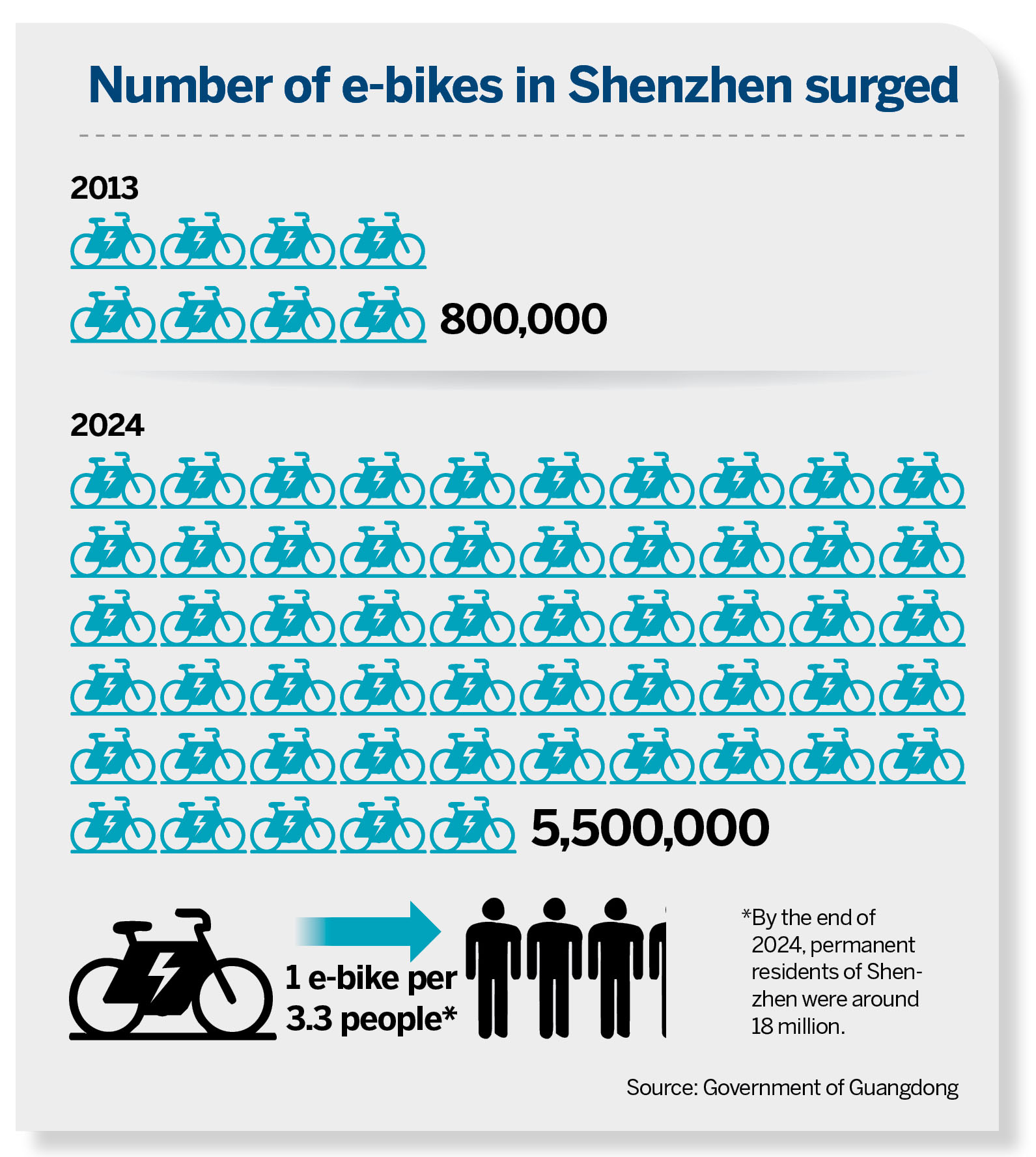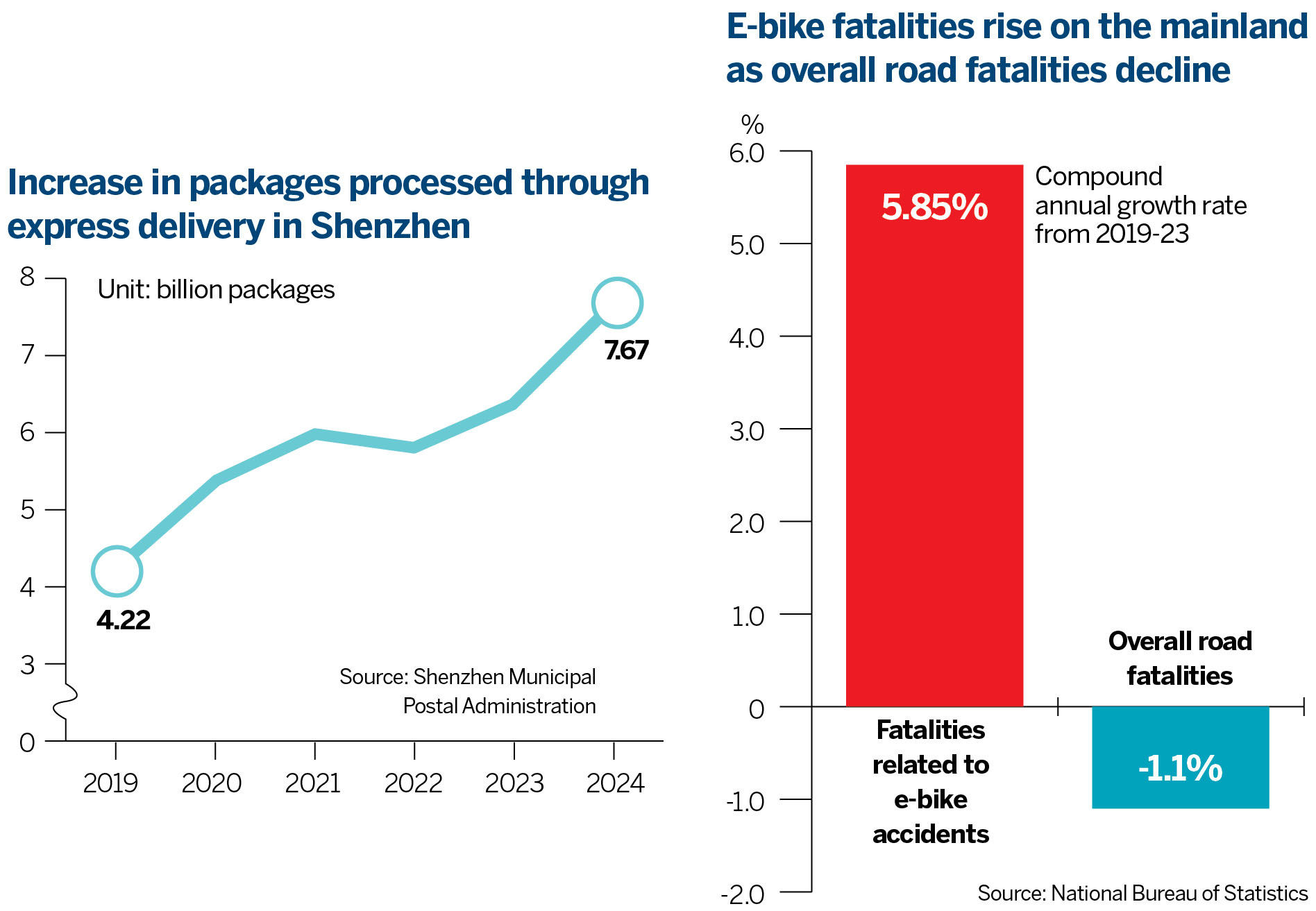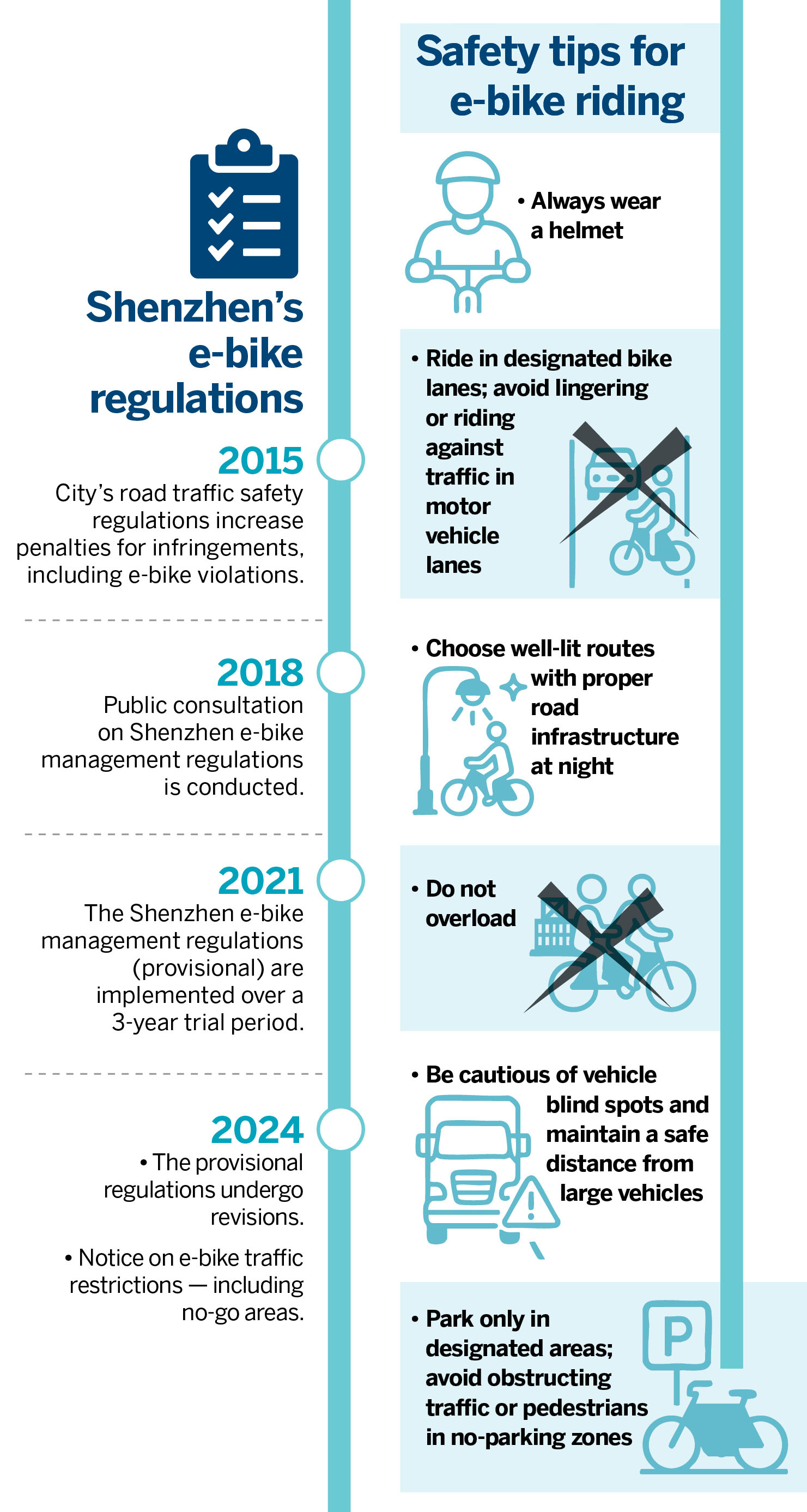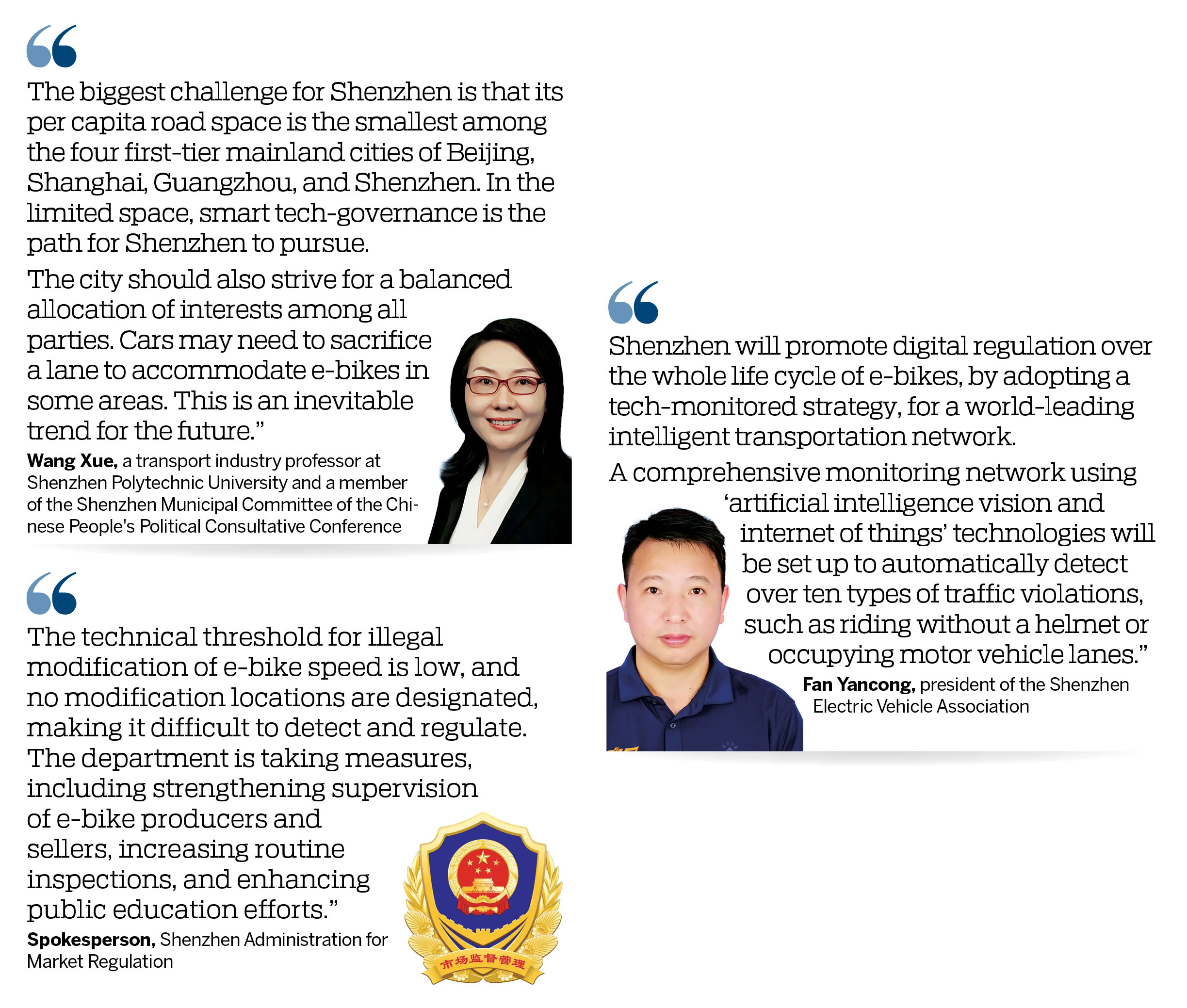Suburban residents of Shenzhen use e-bikes for last-mile connectivity. Since the COVID-19 pandemic, e-commerce and food delivery have driven a surge in the use of e-bikes. Planners are considering enlarging e-bike parking areas and creating dedicated e-bike traffic lanes. Zhou Mo discovers in Shenzhen.

The proliferation of e-bikes in Shenzhen has city planners scrambling to cope. Authorities need to allocate more e-bike parking spaces. Modifications to e-bike speed limits add to traffic accidents, as e-commerce and food delivery services rush to meet online customer demand. An army of 250,000 express and food delivery riders fulfills home orders.
Road safety is compromised too in mixed traffic lanes with cars and trucks. Dedicating a lane to e-bikes is being considered. Given the natural growth of vehicles on inner-city roads, motorists may endure further congestion at peak hours if a lane is switched to e-bike-only use.
READ MORE: Growing number of shared e-bikes a cause for concern in Guangzhou
The New York-based Institute for Transportation and Development Policy, founded in 1985, recommends that governments factor electric bicycles holistically within the total urban transport matrix for sustainable urban mobility. It is a new phenomenon for urban planners.

Forest of e-bikes
E-bikes crammed onto pavements are an obstacle course for pedestrians. This is particularly acute in Shenzhen’s Shuibei area, one of the largest gold and jewelry industrial clusters in China. “I feel I’m fighting my way through a jungle of bikes. It’s so frustrating,” said Cao Lihua, who runs a jewelry shop in Shuibei.
The city’s rapid urbanization and digital supremacy as China’s Silicon Valley aggregated 18 million permanent residents by the end of 2024, an increase of 7.37 million from 10.63 million in 2013. About 5.5 million e-bikes were registered in Shenzhen last year, compared with 800,000 in 2013.
While there appears to have been a six-fold increase in e-bikes over 10 years, the 2013 number could be low due to underrecorded vehicles — mandatory registration was implemented only from 2022. As Shenzhen’s population has outgrown the city’s facilities, suburban residents have increasingly begun to access public transport using e-bikes for last-mile connectivity.

The rapid growth of e-commerce and food delivery businesses has added to the traffic load. Online retail sales in Shenzhen hit 230 billion yuan ($32 billion) last year, ranking among the top Chinese mainland cities. Express delivery processed 7.67 billion packages in 2024, growing 20 percent year-on-year.
Wang Xue, a transport industry professor at Shenzhen Polytechnic University and a member of the Shenzhen Municipal Committee of the Chinese People’s Political Consultative Conference, said, “Shenzhen didn’t start the registration process for all e-bikes until 2022. The 800,000 statistic in 2013 may only cover e-bikes for civil uses, such as express or water delivery. Individual users were not recorded. The actual number of e-bikes in 2013 was likely much higher.”

High e-bike density
Shenzhen’s relatively small area of 1,997 square kilometers — compared with other first-tier mainland cities — averaged 2,754 e-bikes per square kilometer in 2024. Beijing, at 16,410 square kilometers, had 305 e-bikes per square kilometer in the same year, according to the Beijing Bicycle Industry Association. Guangzhou, at 7,434 square kilometers, had over 6 million e-bikes as of July 2024, equivalent to 807 e-bikes per square kilometer.
“The biggest challenge for Shenzhen is that its per capita road space is the smallest among the four first-tier mainland cities of Beijing, Shanghai, Guangzhou and Shenzhen. In the limited space, smart tech-governance is the path for Shenzhen to pursue,” said Wang.
“The city should also strive for a balanced allocation of interests among all parties. Cars may need to sacrifice a lane to accommodate e-bikes in some areas. This is an inevitable trend for the future,” she added.

Traffic accidents
A meeting of the CPPCC’s Shenzhen Municipal Committee, held in July 2024, noted that traffic police dealt with 1.4 million e-bike violations from January to July of 2024, an increase of 10.4 percent year-on-year.
The unruly riding of e-bikes heightens safety risks, with some riders weaving through motor vehicles and ignoring traffic regulations. Among Shenzhen’s e-bike-related traffic accidents last year, 81 percent occurred in mixed road sections used by both pedestrians and vehicles.
Of the 5.5 million e-bikes in Shenzhen, the 10 percent that carry express packages and food make the most trips, said Wang. “Accidents mostly occur on this type of e-bike,” she added.
Initially, the Shenzhen government addressed the surge in e-bikes by taking a “blocking” approach, which meant they could not be used on expressways in the city. This alone did not solve the problem, said Wang.

The Transport Bureau of Shenzhen Municipality has set an objective to create 300 to 500 kilometers of e-bike lane each year. Over 700 kilometers of bikeways were constructed or renovated last year, bringing the cumulative length to 4,415 kilometers. More than 1,100 e-bike parking areas were built around subways and other road sections in the same year. The transport authorities aim to achieve full coverage on all eligible roads for e-bike use in the city within three years.
Besides reckless riding and haphazard parking, the illegal modification of e-bikes to make them go faster also presents a problem. By national standards, the designed speed of e-bikes should be capped at 25 kilometers per hour, but some vendors have illegally modified vehicles to reach up to 60 kilometers per hour.
A spokesperson for the Shenzhen Administration for Market Regulation told China Daily that the technical threshold for modifying e-bike speed is low and that no designated modification locations exist, making it difficult to detect and regulate.
The department is taking measures to crack down on the practice, including strengthening supervision of e-bike producers and sellers, increasing routine inspections, and enhancing public education efforts. There is no specific legislation on the illegal modification of e-bikes at the national or Guangdong provincial level.
In Shenzhen, revision of e-bike regulations is ongoing and will include penalties for illegally tampering with speed limits. These revised regulations are to be released soon.

AI tech vigilance
Fan Yancong, president of the Shenzhen Electric Vehicle Association, said technology-powered management will be the key to easing Shenzhen’s e-bike dilemma.
“Shenzhen will promote digital regulation over the whole life cycle of e-bikes, by adopting a tech-monitored strategy, for a world-leading intelligent transportation network,” he said.
ALSO READ: Market monitors, security officials must take steps to end e-bike menace
A comprehensive monitoring network using “artificial intelligence vision and internet of things” technologies will be set up to automatically detect over ten types of traffic violations, such as riding without a helmet or occupying motor vehicle lanes, said Fan. He added that riders’ profiles will be created for a three-color-code tiered management model to better regulate the e-bike sector.
Next Actions
1. Extend lanes to accommodate e-bike growth.
2. Allocate e-bike spaces to reduce haphazard parking.
3. Introduce legislation to integrate all traffic types.
4. Use tech-based optimization of transport ecosystem.
Contact the writer at sally@chinadailyhk.com


